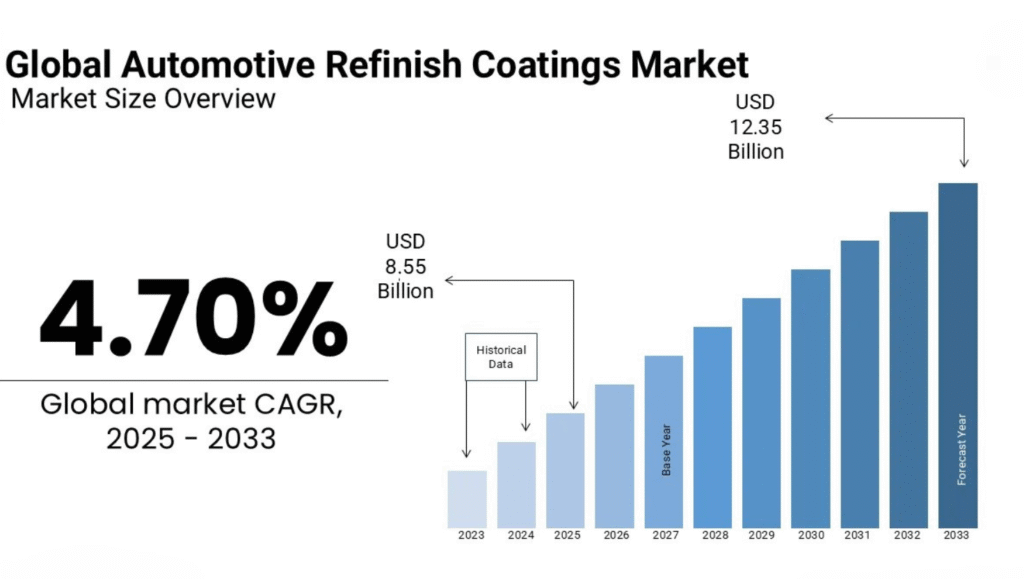
With India’s automotive industry racing toward a sustainable future, the Global Automotive Refinish Coatings Market Report 2025 reveals a sector brimming with innovation, propelled by eco-conscious technologies and the electric vehicle (EV) boom. Pegged at USD 11.2 billion in 2024, the global market is set to climb to USD 15.8 billion by 2032, growing at a 4.4% CAGR, according to a 2025 Allied Market Research report.
For India’s ₹35,000 crore coatings industry, the report signals a golden opportunity to capitalize on green and digital advancements, though MSMEs face steep hurdles in R&D and regulatory compliance to seize a USD 2 billion domestic market by 2030.
The report spotlights a trio of trends redefining automotive refinish coatings. Sustainability takes center stage, with waterborne coatings like Axalta’s Spies Hecker Permahyd reducing VOC emissions by 40% and bio-based alternatives cutting fossil fuel dependency by 20%, per a 2024 Progress in Organic Coatings study.
These align with India’s environmental mandates and Europe’s Green Deal, per a 2025 Coatings World report.
Digitalization is another game-changer, with tools like BASF’s Refinity and Nippon Paint’s SpectraScan streamlining color matching and inventory management, slashing waste by 15%, per a 2025 Automotive Refinishing Journal. Meanwhile, EV-tailored coatings, such as PPG’s conductive primers, enhance battery durability and thermal management, critical for India’s EV market, expanding at a 45% CAGR, per a 2024 NITI Aayog report.
Indian manufacturers, including Asian Paints, Kansai Nerolac, and Berger Paints, are embracing these trends, rolling out low-VOC basecoat and clear coats for collision repair centers, per a 2025 Business Standard report.
Global leaders like Sherwin-Williams, AkzoNobel, and BASF drive innovation with scratch-resistant, UV-stable finishes, per a 2025 PaintSquare report. MSMEs, contributing 30% to the supply chain, tap into the ₹50,000 crore PLI scheme and ONDC, boosting market reach by 20%, per a 2024 SIDBI report.
Employing 350,000 workers, the sector curbs high-performance resin imports by 15%, saving USD 1.2 billion annually, per a 2024 UNCTAD report. Still, India imports 40% of advanced raw materials from China, Germany, and Japan due to limited domestic R&D, per a 2025 Economic Times report.
The economic ripple effects are significant. Green coatings reduce Extended Producer Responsibility (EPR) costs by 20% and open export markets in sustainability-driven regions, per a 2025 Hindustan Times report.
Digital tools enhance body shop efficiency, lifting margins by 15%, while EV coatings support India’s 30% electrification target by 2030, per a 2024 CII report. The industry dovetails with Make in India and Swachh Bharat, advancing SDG goals, per a 2025 MoEFCC report.
Yet, challenges loom large. Regulatory clearances in India take 4–6 years compared to China’s 2, stifling innovation, per a 2024 Nasscom report. MSMEs bear ₹1–2 lakh monthly compliance costs, and power outages disrupt 20% of operations.
Only 5% of Skill India’s 2 million trainees are versed in cutting-edge coating tech, and ONDC adoption stalls at 15%, per a 2024 Nasscom report.
Industry experts advocate for Technology Upgradation Scheme subsidies, Skill India programs, PM Gati Shakti’s 5G infrastructure, and IIT R&D tie-ups, per a 2025 LatestLY report. CII-led initiatives could amplify ONDC adoption and public awareness.
The Global Automotive Refinish Coatings Market Report 2025 charts a roadmap for India to steer its coatings industry toward global leadership. By scaling green and digital innovations, India can trim imports, fuel economic growth, and accelerate toward a Viksit Bharat by 2030.
